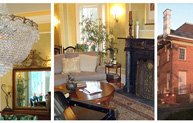A contractor, a team of designers and Sherwin-Williams join forces to revive a historic New York home.
As a kid growing up in Loudonville, N.Y., Nathaniel Bette remembers being intrigued by the house next door. Built in 1840, it was older than the other homes in the neighborhood, with a sweeping view of the Helderberg Mountains. It had a pedigree; its previous owners included a Civil War general, a state assemblyman and several generations of a local brewing dynasty. The house even had a name: Prospect Place.
But when the house came on the market in late 2009, it had seen better days. "It was a big mess, kind of an eyesore," recalls Bette, now a contractor. However, Bette was determined to restore it to its former glory, while also enhancing it to accommodate modern living. "I wanted to salvage a nice piece of history," he says.
For help, he turned to a team of local designers and to Vanguard, the volunteer arm of the Albany Symphony Orchestra. For 31 years, Vanguard has partnered annually with local design professionals to transform an area home into a designer showcase.
The Vanguard committee knew Prospect Place was a perfect candidate for this year's fundraiser. "It's an incredible house," says chairwoman Barbara Richer. "Folks really enjoy historic homes."
And the fact that it really needed help was an added bonus. "It was pretty close to destruction," Richer says. "To bring it back from the brink – to add color, life and joy – has been remarkable."
Originally built as a summer cottage, the house was structurally sound, but in poor shape cosmetically, and its kitchen and bathrooms were long overdue for an update. Bette's company, Empire Construction Group, put on a large addition that expanded the kitchen and added a mudroom and screen porch.
"The biggest challenge was getting a good master plan that covered all the bases: How do you preserve the architecture, not take anything away that has historical value, but still make it livable for a 21st-century family?" says Bette.
About two dozen designers and decorative artists volunteered to tackle specific rooms and spaces in the home, and Sherwin-Williams signed on as a major sponsor, donating the interior coatings for every room.

Paint's Possibilities
"Sherwin-Williams is responsible for all the colors and faux treatments in the house," says Richer. "It's a terrific representation of the different things you can do with paint."
In the living/dining room, for example, Richard Bresette, an artist, decorative painter and interior designer, RichArt Interiors, used an ancient faux technique called "frottage" to bring warmth and depth to a formerly chilly space.
"I wanted relaxed, casual formality," he says. "We've all been in those intimidating spaces," and he was determined that the redesigned living area would be anything but. He had picture molding added to the walls, in "a nod to the period," he says, then used different paint colors and textures to define and warm up those areas.
Using Ancestral Gold (SW 6407) and Blonde (SW 6128) as a starting point, Bresette added universal tints to both colors to achieve a custom combination of light olive green and gold. Then he used a metallic silver [Sherwin-Williams Faux ImpressionsTM tinted with Sticks and Stones, (SW 7503)] and a touch of raw umber pigment "to age it." Crumpled newsprint, applied to the wet metallic top coat, created a marbled effect. "It's a very soothing and relaxing palette," he says.
Upstairs, Shannon McGivern, decorative products specialist for Sherwin-Williams, also used Faux Impressions to create a distinctive look for the Jack-and-Jill bathroom. Her biggest challenge was creating a modern bathroom that still complemented the traditional, Federal-style rooms (a women's study and a guest bedroom) on either side.
McGivern's design combines metallic glass tiles (currently right on trend) with classic elements such as white subway tiles and an antique clawfoot tub. Then she painted the walls a base color, Griffin (SW 7026), "a bronze-y dark brown," and finished with a tinted metallic glaze (Griffin SWF 309). "It's all about the shimmer," she says.
Bette took an active role in vetting the designs for every room and space. "We told the designers we wanted it to be timeless, not trendy," he said. "We wanted to preserve history, but we didn't want it to be a museum. We want someone to actually enjoy it and live in it, and not let it fall into a derelict condition like it was before."
Bette's precision even resulted in a new paint color: "Prospect Place White," a warm, creamy white that Sherwin-Williams created just for this project, based on what Bette wanted for the woodwork, Richer says.
The new hue already has a strong local following. "It's enormously popular with designers," adds Richer.
The house is currently on the market for $2.21 million. Early response to the restoration has been very favorable, but for Bette, whose parents still live next door, the best compliment came from one of the previous owner's grandchildren: "He said, 'Thanks for saving it,'" Bette says. "They're really happy with it." And so is he. "I had a good time doing this one."








